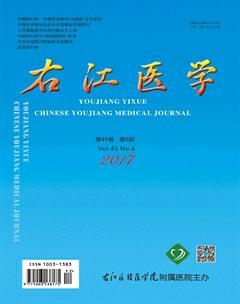轻型缺血性卒中静脉溶栓后双重抗血小板治疗研究
张晓鑫+王艳+杨清成


【摘要】目的观察轻型缺血性卒中患者重组组织型纤溶酶原激活剂(rt-PA)静脉溶栓后使用双重抗血小板治疗的临床疗效。方法选取2013年7月~2016年10月在神经内科治疗的80例轻型缺血性卒中患者,按治疗方法分为传统组(n=40)和观察组(n=40)。传统组静脉溶栓后给予阿司匹林长期治疗;观察组静脉溶栓后给予阿司匹林联合氯吡格雷治疗3周,然后继续单用阿司匹林长期治疗。3个月后评估两组患者的NIHSS评分、BI评分、mRS评分,评估3个月内患者的脑出血率、病死率和脑梗死复发率。结果两组患者入院时NIHSS评分差异无统计学意义(P>0.05);治疗3个月后,传统组患者预后情况较观察组差(P<0.05);观察组脑梗死复发率低于传统组,但比较差异无统计学意义(P>0.05)。结论轻型缺血性卒中静脉溶栓后,短期给予双重抗血小板治疗能够提高疗效,脑梗死复发率略有降低,且不增加出血的风险。
【关键词】轻型;缺血性卒中;双重抗血小板
中图分类号:R743.3文献标识码:ADOI:10.3969/j.issn.1003-1383.2017.06.014
【Abstract】ObjectiveTo observe the clinical efficacy of dual antiplatelet therapy after the recombinant tissue plasminogen activator (rt-PA) intravenous thrombolysis in patients with light ischemic stroke.Methods80 cases of light ischemic stroke patients treated in department of neurology from July,2013 to October,2016 were selected.All patients were divided into traditional group(n=40)and observation group(n=40)according to treatment method.The traditional group were given long-term aspirin treatment after intravenous thrombolysis;the observation group were treated with aspirin combined with clopidogrel for 3 weeks after intravenous thrombolysis,and then aspirin alone was continued to be use for long-term treatment.After 3 months,NIHSS score,BI score and mRS score of the two groups were evaluated,and the cerebral hemorrhage rate,mortality rate and recurrence rate of cerebral infarction were evaluated within 3 months.ResultsThere was no statistically significant difference in NIHSS scores between the two groups at admission(P>0.05).After 3 months of treatment,the prognosis of the traditional group was worse than that of the observation group(P<0.05).The recurrence rate of cerebral infarction in the observation group was lower than that in the traditional group,but difference was not statistically significant(P>0.05).ConclusionAfter the thrombolytic thrombolysis of light ischemic stroke,short-term double antiplatelet therapy can improve the efficacy,reduce the incidence of cerebral infarction,and do not increase the risk of bleeding
【Key words】light;ischemic stroke;double antiplatelet
輕型卒中是一种血管原因所致的突发性局灶性轻型神经功能障碍(NIHSS≤3分),持续时间≥24 h[1]。在急性脑血管病事件中,轻型卒中包括短暂性脑缺血发作(TIA)和急性缺血性卒中;其临床表现为一过性肢体麻木、无力、失语、失神等神经功能障碍,可以完全缓解或者症状轻微,常不引起人们的重视,或者重视不充分,之后往往导致灾难性后果。因此,该研究旨在分析轻型急性缺血性脑卒中患者静脉溶栓后,采用双重抗血小板治疗的安全性及疗效,现报道如下。1资料与方法1.1临床资料选取2013年7月~2016年10月在我院神经内科治疗的80例轻型缺血性卒中患者,所有患者的临床症状和检查结果均符合指南标准和溶栓标准。溶栓标准:①年龄18~70岁;②引起可评估的神经缺损;③卒中持续1 h无改善;④发病时间在4~5 h内;⑤NIHSS评分≥4分;⑥排除脑内出血,无早期大面积脑梗死改变。传统组40例,男24例,女16例;年龄50~77岁,平均(64.5±7.9)岁;发病时间60~242 min,平均(130.8±22.4)min;合并高血压12例,糖尿病3例。观察组40例,男26例,女14例;年龄52~76岁,平均(63.8±7.5)岁;发病时间55~246 min,平均(131.4±22.9)min;合并高血压10例,糖尿病4例。两组患者的性别、年龄、发病时间、合并症等比较差异无统计学意义(P>0.05),有可比性。endprint

